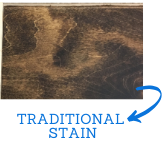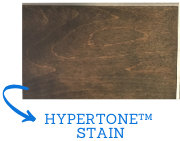What causes “blotchy” stain?
All hardwoods and softwoods have some kind of grain pattern and density differences due to its growth. This is  completely natural, but the grain and differences in density are highlighted by the stain. Maple, like several others species such as walnut, American cherry,
pine and Douglas fir, do not take stain as evenly as species such as red oak and white oak.Blotchy color can result from other factors as well, such as inconsistent sanding procedures, water-popping, or stain application. Inadequate preparatory
procedures can result in previous coatings being left in the wood, also preventing uniform color.
completely natural, but the grain and differences in density are highlighted by the stain. Maple, like several others species such as walnut, American cherry,
pine and Douglas fir, do not take stain as evenly as species such as red oak and white oak.Blotchy color can result from other factors as well, such as inconsistent sanding procedures, water-popping, or stain application. Inadequate preparatory
procedures can result in previous coatings being left in the wood, also preventing uniform color.
Many techniques have been tried to correct the issue, including pretreatments, layering stain, and excessive tinting of finish. Contractors notoriously try to apply products outside of the manufacturer's recommendations. Unfortunately, attempts
to force an outcome often ends in a failure.
How can I get maple to take stain better?
The first step to ensuring the best possible outcome is to follow NWFA guidelines to sand and prepare the floor properly.  Water-popping will also help make sure the color is absorbed more evenly.
Water-popping will also help make sure the color is absorbed more evenly.
Contractors tend to get comfortable with products or procedures they prefer to use, but advancements in floor product technologies do offer some possible solutions. The manufacturers of prefinished products that you’re frustrated with having
to match have sought out the products they needed to achieve the results their customers have demanded. You should do the same by looking for alternative products better suited for any given project.
Basic Coatings® offers a unique solution that resolves a lot of the challenges to job-site maple staining in HyperTone Stains, a water/oil hybrid. Please click here to learn more.